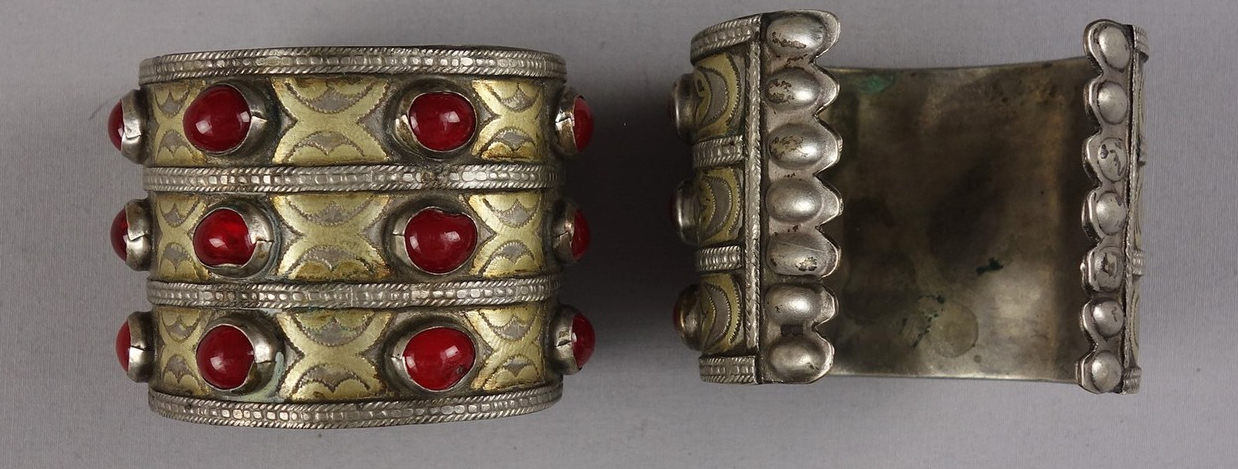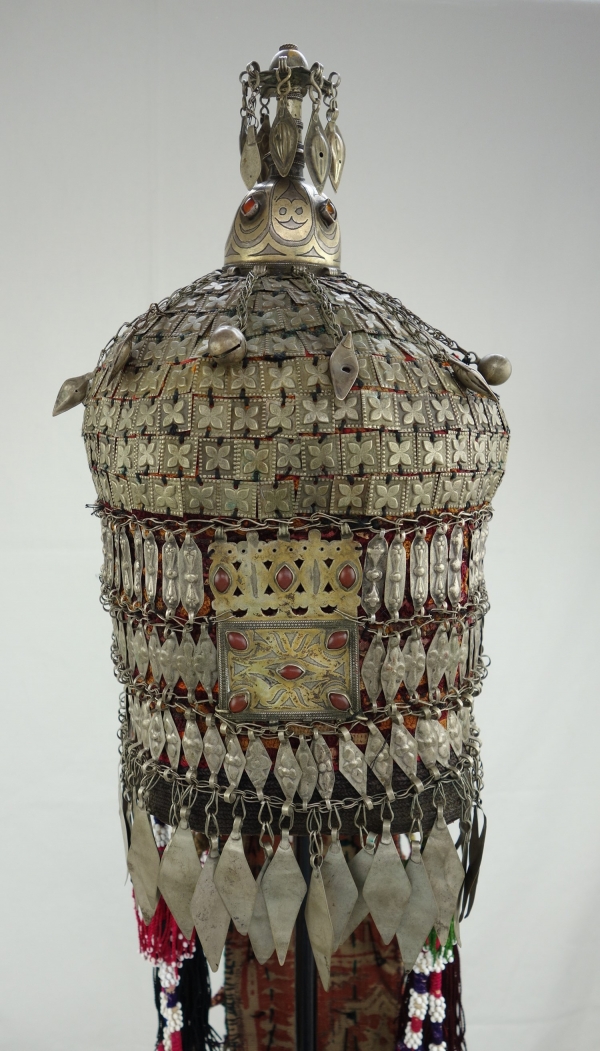Jewellery, especially that worn by women, has long played an important role in Central Asian life. It is not only decorative, but it has both amuletic (against the evil eye) and talismanic (attracting positive) properties. In particular, silver is seen as having the power to reflect evil away from the wearer. Equally important, however, is the fact that it is the property of the woman herself and indicates her family’s social and economic status, while providing her with a source of funding should family circumstances change for the worse.
There have been some significant changes in the form of jewellery worn over the decades. At the beginning of the 20th century, for example, a Turkmen bride might wear up to five kilos of silver jewellery as a sign of her status and value. By the end of the 20th century, however, few women were still prepared to carry such a weight of jewellery. Another change is the move from silver to gold forms. Much of the gold jewellery, however, is not heavy as it is not massive gold, but a sheet form that comes from India and, more recently, China.
 Two silver Turkmen bracelets. Iran, late 20th century. TRC 1999.0321a-b. For more information, click on the illustration.The main types of traditional jewellery
Two silver Turkmen bracelets. Iran, late 20th century. TRC 1999.0321a-b. For more information, click on the illustration.The main types of traditional jewellery
The head is regarded as the most important and visible part of the human body, so it is not surprising that considerable attention was and is paid in Central Asia to the various forms of jewellery worn on the head. These include diadems, which are especially large among the Turkmen, and very delicate among the Tajik and Uzbek, to linked bands that are hung horizontally along the sides of the head, as well as hanging down just in front of the ears. Forehead jewellery consists of linked bands, often with small pendants that reach just above the eyes. Earrings and nose rings also abound and come in many different forms and sizes. Large plaques, often of a heart shape, are made for hanging down the back of the head and over a woman’s plaited hair. They are regarded as having an amuletic property, as well as decorating this part of the wearer’s body.
Around the neck is worn a variety of different types of necklaces, from amuletic forms made of spices, notably cloves, to large silver plaques embellished with semi-precious stones, notably carnelian (amulet), turquoise (talisman) and lapis lazuli (talisman). Armbands, bracelets and finger rings also play an important role in the jewellery wardrobe and come in many forms. In particular, armbands and bracelets are often worn in pairs. With respect to the finger rings, each finger has a different type of ring. Around the waist, a number of different types of belts are worn, depending on where the woman comes from and the status of the family. Poorer women or those wearing ‘daily’ forms may opt for a cloth sash to keep their dresses and coats in place.
 A pair of decorative metal bands for embellishing a Turkmen woman's headdress. TRC 1999.0191. For more information, click on the illustration.In contrast to the jewellery worn by women, men’s jewellery is traditionally limited, in keeping with the general Islamic ban on the wearing of silks and gold jewellery by men. Men’s accessories mainly come in the form of silver rings, especially for a man who has been on a pilgrimage to Mecca, and in a traditional setting, namely swords, daggers and firearms with elaborate stocks, but also leather and silver satchels. Often more time and money was spent on a man’s horse and its decoration, than on the wearer himself, because a horse and its equipment were a very public announcement of the owner’s status.
A pair of decorative metal bands for embellishing a Turkmen woman's headdress. TRC 1999.0191. For more information, click on the illustration.In contrast to the jewellery worn by women, men’s jewellery is traditionally limited, in keeping with the general Islamic ban on the wearing of silks and gold jewellery by men. Men’s accessories mainly come in the form of silver rings, especially for a man who has been on a pilgrimage to Mecca, and in a traditional setting, namely swords, daggers and firearms with elaborate stocks, but also leather and silver satchels. Often more time and money was spent on a man’s horse and its decoration, than on the wearer himself, because a horse and its equipment were a very public announcement of the owner’s status.


